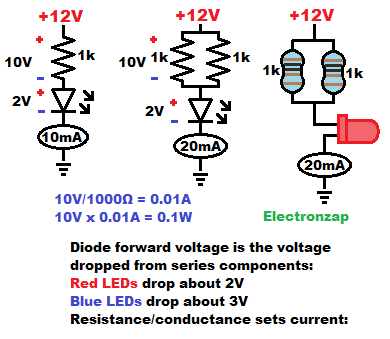Table of Contents
Parallel resistors are connected to each other on both ends. When you connect a fixed voltage across them, then each parallel resistor will pass current independent of the other ones. The current of each resistor will add up to a total current.

The amount of current that passes through each parallel resistor can be calculated with Ohms law. The 2 points (nodes) where the resistor terminals connect together on each end will pass all of the current that flows through every parallel resistor.
10V across a 1,000 ohm resistor will pass about 10mA of current. 10V/1,000Ω = 0.01A (10mA). That’s a good resistance to protect an LED from a 12V power source when using a 1/4W resistor. A lower value 1/4W resistor will probably get too hot. Remember that red indicator LEDs drop about 2V from the current setting resistor(s).
If you want 20mA (indicator LED maximum recommended current) of current through the LED, then you can simply add another 1k (1,000Ω) resistor in parallel with the 1k resistor. They will both pass 10mA of current for a total of 20mA.
Aiming for 15mA instead:

20mA is actually more than you want to put through an indicator LED. It’s much better to put about 15mA through it instead.
Since a red LED in series with a 1k resistor will have about 10mA flowing through the circuit, a 2,000Ω (1k) resistor will in series with an LED will pass about 5mA of current.
Connecting the resistors in parallel with each other will pass approx. 15mA of current through the LED.
Connecting a 1k resistor in parallel with a 2k resistor before connecting the 2 of them in series with an LED, will mean that the LED continues to drop about 2V. With a 12V supply, both resistors will have 10V across them. They will both pass current, and both of those currents will combine to pass through the LED. LEDs don’t limit current once their forward voltage has built up across them.
In the diagram, I also showed the math that you can use to calculate the equivalent value of 2 parallel resistors. 3 or more parallel resistors has a different formula, which will work with 2 parallel resistors as well. In the video, I used a 2,200Ω resistor, which will lower the current a little bit more.
To support this site, check out the following links:
- Check out my YouTube videos! https://www.youtube.com/c/Electronzap/videos
- Products I used in my videos or otherwise think look like a good buy. As an Amazon associate, I earn from qualifying purchases. My Amazon affiliate page showing products I think look good
- Information on this site is not guaranteed to be accurate. Always consult the manufacturer info/datasheet of parts you use. Research the proper safety precautions for everything you do.
- Electronzap is a participant in the Amazon Services LLC Associates Program, an affiliate advertising program designed to provide a means for sites to earn advertising fees by advertising and linking to amazon.com.